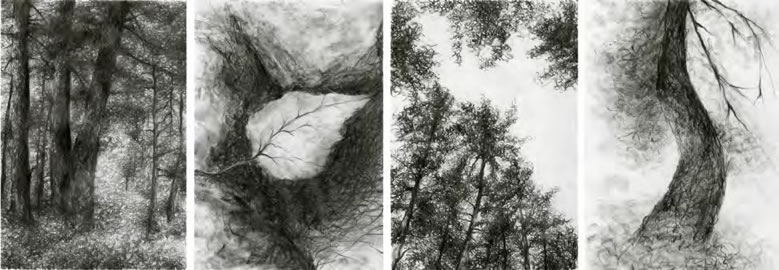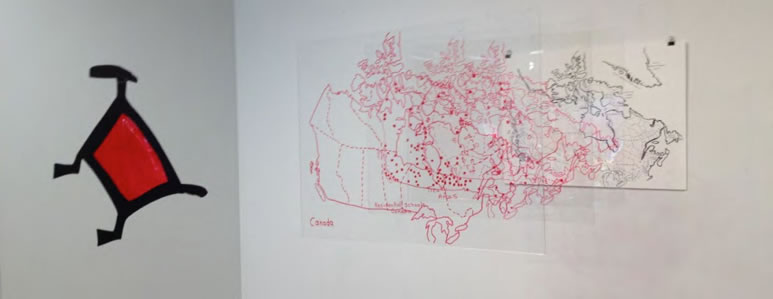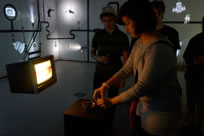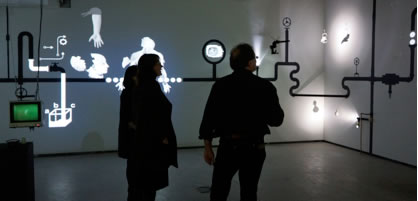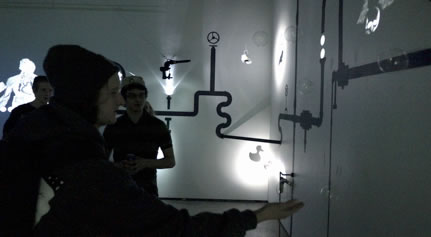Teaching Responsibilities |
2014/15 Visa 300 C (3) / 300 D (3) Advanced Drawing
The focus of this course is to enable students to apply drawing skills in a real-life situation in the community. The course aims to develop specialized skills for success in professional practice and to introduce students to the importance of interdisciplinary and collaborative modes of applied work. The course intends to introduce students to a project that brings their advanced artistic skills into the community in a way that is relevant to the students and to the community. The course focuses on a community-specific drawing project Dig Your Neighbourhood: Mission.
Image: DYN 2015 Posters by Nicola Parker
The course provides the compositional and production bases of digital art and design through contemporary examples and theoretical ideas presented in the lectures as well as project based learning of the practical concepts and skills investigated through the lab exercises, workshops and assignments. The course is focused media communication as a process of sending and receiving messages using media images. Students are introduced to the group of skills that enable them to effectively read and write visual language for intentional communication with others.
Image: Building Futures Interactive Installation 2015 Elias Wardle et al. (VISA 265 Gallery Exhibit)
2013/14 Visa 300 A (3) / 300 B (3) Advanced Drawing
Image: Changing Seasons 2015 Dianne Schnieders et al. (VISA 300 B Gallery Exhibit)
Image: Dion Kaszas Map of Canada representing an Indigenous perspective on the Canadian land and territory, VISA 283
Meaning, content and ideas embedded in the artwork are as important as technical proficiency and sophisticated finish. Collaborative work that integrates traditional and digital art solutions is encouraged. Technical workshops are offered routinely focusing on introducing students to both programming for artistic applications using Max MSP & Jitter and Processing, as well as strategies for integration of traditional and digital art.
2010/11 VISA 460 (3) Special Topics in Visual Art: Electronic Art This fourth year course is focused on practice and theory of electronic art, through lectures, discussions and workshops, with emphases on the artistic, conceptual and expressive quality of produced artwork. The course provides an introduction to computer programming for artists using the MaxMSP & Jitter programming environment. Students exhibit their final interactive installations in the UBCO gallery at the end of the year. 2010/11 VISA 264 (3) / 265 (3) Computer Image Development This second year course provides an introduction to the compositional and production bases of digital art making and the graphic industry through contemporary examples and theoretical ideas presented in lectures as well as project-based learning of the practical concepts and skills investigated through the lab exercises, workshops and assignments. 2011/12 VISA 102 (3) /103 (3) Drawing and Two-dimensional Practices
Image: Oliver Szeleczky, VISA 102 bird flying and horse running animation image sequence This foundation course introduces students to the principles, practices, and concepts central to drawing, two-dimensional art and pictorial form. Approached as a synthesis of disciplines the course focuses on historical and innovative approaches to pictorial representation, as well as the uses of materials, processes, supports and methods of composition. Emphasis is placed on the ways in which these may be tied to the major concepts and practices behind contemporary visual expression. Image: Rankine Suen Wai Yin and Frances Rush VISA 103 2011/12 VISA 482 (6) / 483 (6) Advanced Art Practices This intensive course is a capstone course for fourth-year Fine Arts students in all areas. In consultation with a faculty advisor, students propose a program of study, with an option to pursue work in their chosen area or work in a multi-disciplinary program. Outside reading is required and students engage in seminar and group critiques. 2009/10 IGS 530H (3) Directed Study VISA: Creation of a Video Installation 2010/11 IGS 520F (3) Directed Readings in Improvisation 2010/11 IGS 530M (3) Directed Study VISA: Electronic Art 2010/11 VISA 400 (6) Practicum This Doctor of Arts course presents theories and models of digital media art, through lectures, discussions and workshops. The course endeavors to blend aesthetic theory and criticism with practice and experimentation. The classes are structures in a practice-based studio context with a strong emphasis on complementary theoretical discussions and readings, designed to support student’s production of finished artwork. The lectures cover the practical and the theoretical concepts that underline the use of computers in the context of media artwork. We view examples of how artists and designers are using computers to create interactive installations, software art, motion graphics, information visualizations, network projects, new forms in architecture and design, and other still-to-be-defined forms of art. We discuss the key new intellectual and cultural concepts introduced by computers such as interactivity, databases, network, artificial intelligence and artificial life.
|


